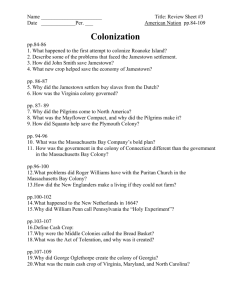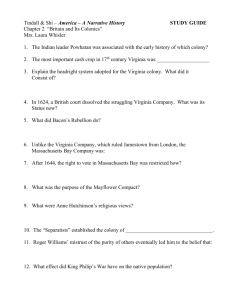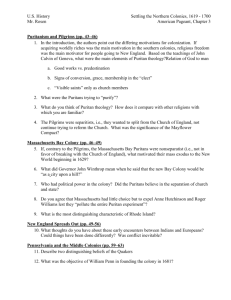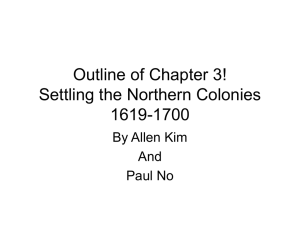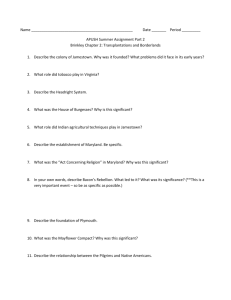English Colonies
advertisement
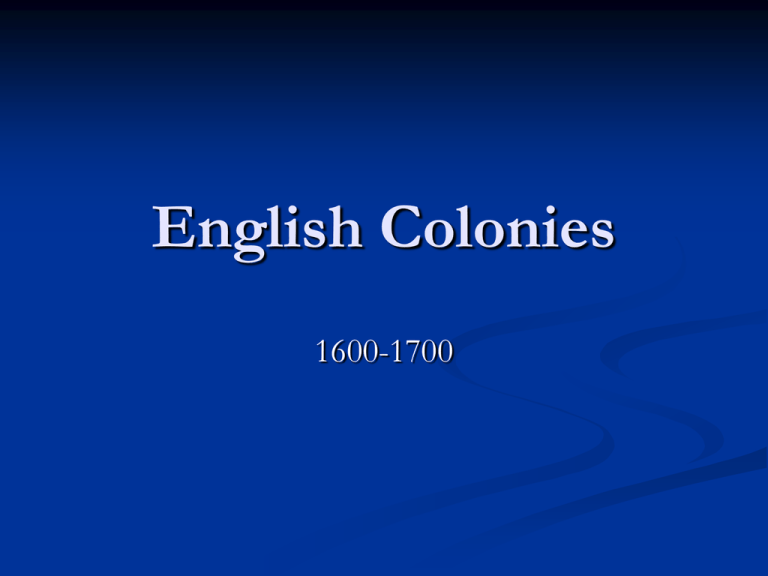
English Colonies 1600-1700 AP Outline 2. Transatlantic Encounters and Colonial Beginnings, 1492-1690 A. First European contacts with Native Americans B. Spain's empire in North America C. French colonization of Canada D. English settlement of New England, the Mid-Atlantic region, and the South E. From servitude to slavery in the Chesapeake region F. Religious diversity in the American colonies G. Resistance to colonial authority: Bacon's Rebellion, the Glorious Revolution, and the Pueblo Revolt 3. Colonial North America, 1690-1754 A. Population growth and immigration B. Transatlantic trade and the growth of seaports C. The eighteenth-century back country D. Growth of plantation economies and slave societies E. The Enlightenment and the Great Awakening F. Colonial governments and imperial policy in British North America Possible Essay Questions Compare the ways in which religion shaped the development of colonial society (to 1740) in TWO of the following regions: New England Chesapeake Middle Atlantic “The English founded colonies to escape oppression in England.” Assess the validity of this statement. “Geography was the primary factor in shaping the development of the British colonies in North America” Assess the validity of this statement for the 1600’s. English Exploration Cabot-(1497) explored for the English, Newfoundland, looking for Northwest Passage, claimed Northern portion of North America for English English Empire= Ireland English began to invade and control Ireland in the early 1400s. They found that it was not possible to pacify the Irish readily and created a pattern that was repeated in the New World. Plantation- different than a large farm- really a system of planting settlers in a hostile territory in an effort to hold the land. Pattern: First try to negotiate for land and allegiance Expel the natives Move in population Parallels to North American Indians and Irish were clear -1607 Jamestown is Founded -1620 Pilgrims Land in Plymouth -1639-1640 The Great Migration -1634 Lord Baltimore Founds Maryland -1636 Thomas Hooker Founds Connecticut Puritans Found Harvard University 1639 Fundamental Orders Written in Connecticut1644 Roger Williams Established Rhode Island -1663 The Carolinas are Founded 1664 The English Take New York From the Dutch Timeline -1675 King Phillip’s War -1676 Bacon’s Rebellion -1679 New Hampshire is Established -1682 William Penn Founds Pennsylvania -1702 New Jersey Units Under a Royal Charter -1712 The Carolinas are Divided Into North and South -1732 Oglethorpe Founds Georgia for Debtors Chesapeake/Virginia/Roanoke/ Jamestown (1584) Elizabeth I began English monarch’s sponsorship of colonies in North America Queen gave Gilbert a license, when he died the, half brother – Walter Raleigh the license to start a colony in North America. 1585 Raleigh sent settlers to Roanoke, part of original VirginiaAfter a number of expeditions, settlers of Roanoke disappeared and they were never seen again, mysterious note of Croatoan carved on a tree. (1590) Joint-Stock Company Private investors bought shares in trading companies and sponsored colonies in America Business Run Colony= reduced royal control These companies contracted with the crown example: The Virginia Company of London (Southern land) 1606 sent 3 ships, 144 men established JamestownChesapeake area. The Virginia Company of Plymouth (Northern Land Grant) Jamestown: First permanent English settlement in America Named after King James I Settlement was in bad location, low, swampy land, malaria was common Algonquian Chief Powhatan- daughter was Pocahontas Captain John Smith was one early officer of the colony- helped bring order to the colony by creating strict rules to live by. Jamestown: Social Early period, mostly males, “get rich quick” single, 4-5 males to 1 female Few women, few families, hunting for gold Life was difficult, starvation common early “The Starving Time” Population was lured to Jamestown through Indentured Servitude, passage to new world in exchange for working the land for a specific period of time. The hope was that after the period of servitude land would be obtained. Very individualistic Headright- system, in an effort to encourage immigration to Virginia, land-grant of 50 acres Jamestown: Relationship with Indians At first the Indians tolerated the colonists and even helped provide food, and agriculture techniques (John Smith- was captured and released) Later hostilities break out, open and periodic warfare Indians and Anglo societies do not mix from the beginning. Issues of land ownership, land use, pattern of living cause conflict- to last through till the 20th century Jamestown: Economic First years were subsistence agriculture, learning form Indians what crops to grow to live Later Tobacco economy develops as a cash crop for very lucrative trade. John Rolfe is and example of tobacco entrepreneur (married Pocahontas) As labor demands increase, African slaves begin to be imported in 1619 Other industries develop to sustain the colony: lumber, glassworks, ironworks… Jamestown: Political 1619, the Virginia Company created the first representative body in America, the House of Burgesses Governor appointed by the Crown Royal Colony A colony controlled directly by the Crown of England, not a private company 1624, James I revoked the charter of the Virginia Company because of debts Maryland 1632 Charles I, divided Virginia and gave part to George Calvert or Lord BaltimoreProprietary Colony- colony under the control of a single owner- but loyal to the Crown Calvert was a catholic- allowed Catholics to move, “Catholic Refuge” but still a minority, mostly protestants. 1649, Act of Toleration or “Act Concerning Religion” the Calverts persuaded the Assembly to adopt a law of religious toleration- but only for Christians Maryland: Strong control by Proprietor, Lord Baltimore Tobacco Economy Large plantations Slave labor Headright System Refuge for Catholics Indentured Servants Which Colony would appreciate this poem most? They cry, they roar for anguish sore, And gnaw their tongues for horrour. But get away Without delay, Christ pitties not your cry: Depart to Hell, there may you yell, And roar Eternally. New England Colonies: Religious Motives v. Money Puritans or English Calvinistsrejected Catholicism and were critical of English King Jamessome left and were known as Separatists also known as Pilgrims. Virginia Company of Plymouthallowed Pilgrims to settleMayflower- 102 people, ½ Pilgrims 1620- Established Plymouth Colony Not Sanctioned by crown till later when merged with Mass Bay Mayflower Compact Before Pilgrims stepped ashore in America they created an covenant or contract- to abide by the laws of the community and to create a government- (this was not a constitution) Plymouth: Social Aspects Traveled in families- tight community Very religious- intolerant of differences Small population, grows to 300 after 10 years Some cooperation with Indians at first later conflicts occur Literacy important Economic Aspects No large plantations Small landholdings Traded fur, fish, lumber Strong work ethic Political Male dominated Election of governorWilliam Bradfordserved for 30 years Massachusetts Bay The Second colony to be founded in the North Charter from King, Massachusetts Bay Company- Joint Stock Company Share holders elected John Winthrop as Governor 1630- 1000 settlers came- no control by owners in England Boston area and Eastern Massachusetts Massachusetts Bay Colony Very religious community/Puritans Winthrop wanted to create the a holy model of purity“City upon a hill” as an example to all John Cotton- was a prominent clergyman/community leader urged religious piety All adult free men, part of a Puritan congregation could vote Town hall meetings used to discuss and vote on local matters ** one significant factor, no religious leader could hold office. Great Migration 1630s during the English Civil War 15,000, many puritans move to Massachusetts Bay. More people moved to New England than in Virginia 1696- 87,000 pop (NE) 1700 Massachusetts = 56,000 -Virginia 42,000 New England: Mixed Economy Individual farmers No large cash crop Traded: lumber, ships stores, ship building, sawmills, fish, livestock, participated in slave trade- to the West Indies (Caribbean) Protestant Work Ethic One of the most influential contributions the Puritan culture offered and continues through today is the idea of hard work. Puritans believed hard work was the way to salvation. 1636 Harvard and the Puritans Puritans created the first universities in British coloniesTo educate the clergy. Anne Hutchinson Out-spoken woman of Mass Bay Believed and stated many clergy were not part of the “elect” and should not have authority Known as the Antinomian heresy. Was banished from Mass Bay went to Rhode Island Rhode Island Roger Williams -- minister from Salem a. Extreme Separatist who challenged legality of Plymouth and Bay Colony charters because land belonged to Indians and was not the king’s land to grant. -- Claimed colony took land from Indians w/o fair compensation b. "liberty of conscience" i. Williams denied authority of civil gov't to regulate religious behavior. -- Stated gov’t could only punish civil crimes while the church alone had responsibility for religious discipline. -Stated that no man should be forced to go to church. -- In effect, challenged the basis of the Massachusetts Bay government. c. General Court banished him from colony in October, 1635 and Williams fled in winter of 1636 to Narragansett Bay; sheltered by Indian friends. d. He purchased lands from Indians and founded the community of Providence, accepting all settlers regardless of their beliefs. Rhode Island Connecticut 1635 Thomas Hooker- from Massachusetts Bay Led a group of Puritans west to establish Hartford (Fertile Land) Fundamental Orders of Connecticut: created an independent colony of similar to Mass. Bay; Was the first modern Constitution in America Carolinas Proprietary colony (8 owners)- Mixed populationmany from other coloniesVirginia and Barbados HeadrightsBrought slaves with them, large % of population slaves Fundamental Constitution of Carolina- provide orderdivision of land, Freedom of Conscious (religion) Never was fully enacted Tobacco economy, but included rice, indigo, cotton, North Carolina- 1700- 45000 people Tobacco was paramount 1700 south Carolina had 10,000 people, majority black Split and Royal colony after 1729 New York and New Jersey Proprietary colonies Taken from the Dutch by force (1664) King Charles II sends troops and fleet to take and given to James II. Freedom of religion to all Christians Some participatory government (assembly) Changes to Royal colony in 1685 Trade importantfarming important Pennsylvania Pennsylvania (1681) Proprietary ColonyWilliam Penn given ownership- debts owed by Crown to his family. Refuge for Quakers: “Society of Friends” Beliefs: equality (including gender), no kneeling, no oaths, pacifists, anti-violence, plain clothes Large colony Freedom of worship Diverse populationGerman, Swedes, Fins Political: Penn held much power (nearly absolute) Elected assembly- to help govern English- held power of legal review and regulated trade Friendly relations with Indians
